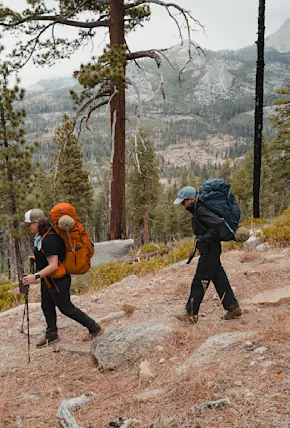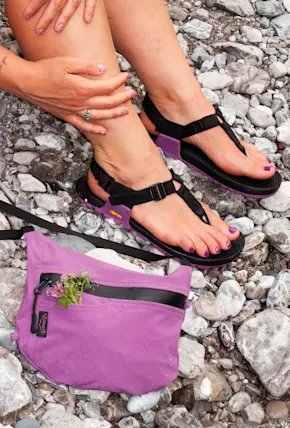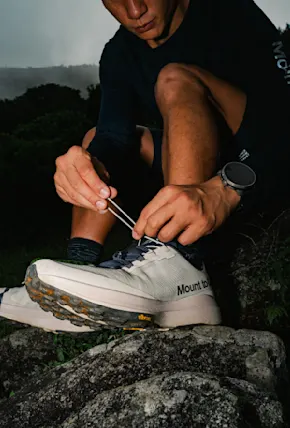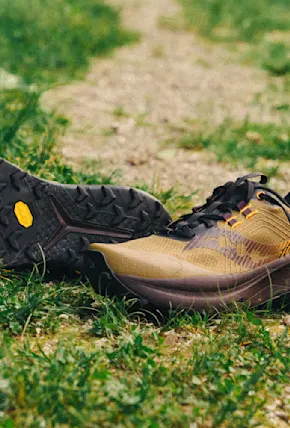Salomon Genesis Specs
Weight: 9.5 ounces
Heel-to-toe drop: 9mm drop
Lug depth: 4.5mm
Features: Matryx upper, Quicklace system, EnergyFoam midsole, Contragrip outsole
Cost: $150 $112 at REI
Pros:
+ Comfortable out of the box
+ Tough yet breathable Matryx upper
+ Stable, confident traction
Cons:
- Midsole compression over time
- Minor durability wear in toe cap delamination
This is a story of “do as I say, not as I do,” because I'll be honest, what I did was stupid. As someone who frequently tests and writes about gear, I know better than to hike more than 100 miles through the Sierra Nevada with a shoe I’d worn exactly twice. The shoe in question: the Salomon Genesis, a relatively affordable trail running shoe made for versatility. Shockingly, they held up so well that I now consider them one of the best trail running shoes for backpacking that you can buy.
But let me back up.
A Trail Running Shoe for UL Backpacking
My original plan was to test the Genesis) while relying on my trusty Hoka Speedgoats as my main shoe through two weeks of hiking on the John Muir Trail. I'm a chronic overplanner and overpacker, and these would be my backup pair. But in the chaos of packing for California, I forgot my Speedgoats entirely. It wasn’t until I conducted a pack shakedown at my parents' home that I realized I had two options: drop $150 on a new pair of Speedgoats at the local REI or risk it with my new Salomons.
That’s how I ended up doing my shake-down hike on Mount Baldy in the Genesis. After all, what's the point of having a backup if you don't use it when you need it? I was worried about covering roughly 11 miles and 4,000 feet of elevation gain on a dirty and gravel trail in box-fresh shoes, but was reassured to discover the shoes felt comfortable and well-cushioned. The Genesis got me out and back with no issues to note.
Still, a one-day hike hardly qualifies as a proper test. The real trial would come over the next 12 days on the John Muir Trail, where I'd traverse 130 miles of granite slabs, dirt trails, packed snowfields, and river crossings and count 26,000 feet of elevation gain and 27,000 feet of descending, often down loose gravel paths, all while wearing a 40-pound pack. Salomon made the Genesis for everyday trail running, not full-on trekking, and there was no way to know how they'd hold up on the route—and no place on my route to swap them out.

The Genesis Is Comfortable Right Out of the Box
One of my biggest concerns heading into the JMT was break-in time—or lack thereof. I've heard horror stories of thru-hikers getting wrecked by new shoes, but never thought I’d be foolish enough to be in that position. Yet here I was, at the start of the JMT, praying that a shoe modeled after the one that had taken Courtney Dauwalter to the finish line when she won her third UTMB would also take me to the highest point in the contiguous United States without any pain.
Thankfully, the Genesis required virtually no break-in period. From the moment I slipped them on at the Florence Lake trailhead on the first day, they offered a supremely cushioned feel that lasted throughout my trip. The cushioned heel locked my foot in place without any slipping, even during steep descents with a heavy pack. My only concern was that the arch, which was a bit higher than that of my Hokas, would cause pain, but it ended up feeling supportive without being intrusive.
Lightweight Feel with Substantial Cushioning
At around 9.5 ounces per shoe, the Genesis sits in that sweet spot of being light enough for trail running but substantial enough for loaded backpacking. Although it’s technically a trail-running shoe (and I wouldn’t even consider myself a speedy hiker), I’ve found trail runners to be ideal for backpacking. I’m not the only one, as their lightweight yet rugged structure has won over much of the hiking and backpacking community. The Energy Foam midsole on the Genesis delivered a balance of cushion, protection, and ground feel that made them feel nimble but not minimalist. I could feel the trail beneath me without getting beat up by every rock and root.
A Roomier Toe Box and a Unique Lacing System
The Salomon Genesis has quite a roomy toe box. I hate to compare favorites, but I felt more wiggle room for my toes here than in the Hoka Speedgoats. The extra space was especially welcome on our descents, with some days tallying nearly 4,000 feet of elevation loss. I didn’t experience any constriction or tightness after any of the 12-mile days we did on the trail either, but that’s not to say I wasn’t happy to take my shoes off at camp. Who wouldn’t be after walking for seven hours?
The toe box is wide, but not high in volume. That is to say, it doesn’t have as much space between the arch and the top of the foot. Runners prone to black toenails or those with high-volume feet might want to try these on carefully before committing to a pair.
I’m typically a traditional lace person, but Salomon’s Quicklace cinch system won me over immediately. Consisting of a cord-like shoelace topped with a locking mechanism, all it takes is one pull, lock it in, and you’re ready to go. There’s even a pocket at the top of the tongue to tuck in the additional cord for a sleek profile with no risk of snags. I found the adjustability convenient as I hiked, and I loved the ease of slipping the shoes off and on during our lunch breaks.









